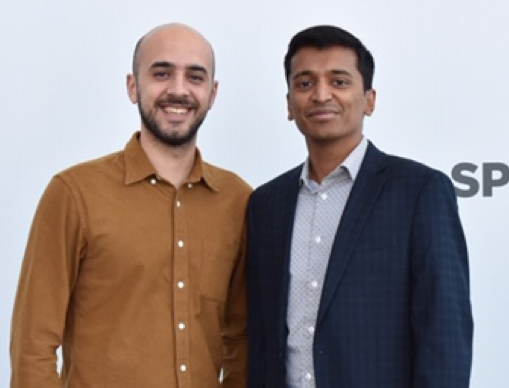Biomedical Engineering Graduate Student Receives Best Paper Award
Sina Dadgar, a biomedical engineering doctoral student, received the Best Paper Award for his research presentation at the annual Photonics West conference organized by the International Society of Optical Engineers. The conference was held in San Francisco from Feb. 1-6 this year.
Dadgar's research is focused on the development of noninvasive optical spectroscopy techniques to monitor tumor response to radiation therapy. He is currently working toward his doctoral degree, under the mentorship of Narasimhan Rajaram, an assistant professor of biomedical engineering.
As part of his research talk in the Multiscale Imaging and Spectroscopy session at SPIE Photonics West Conference, Dadgar discussed his recent investigations into the sensitivity of Raman spectroscopy to changes that occur within tumors treated with radiation therapy. Raman spectroscopy is highly sensitive to molecular vibrations and has high chemical specificity; that is, every molecule has a unique Raman signature.
"The current problem in head and neck oncology is that not all patients respond to treatment. Earlier identification of these patients can enable oncologists to accordingly modify treatment plan to non-responding patients."
Based on a review of the scientific literature, Dadgar identified two unique cancer cell lines derived from a patient - one was resistant to radiation therapy and the other was sensitive to treatment.
Dadgar found that the Raman signatures from the radiation-resistant and radiation-sensitive tumors were different from each other and could potentially be used in patients to determine which patients would not respond to treatment.
Dadgar considers himself an unconventional candidate for the award, as the field of biomedical engineering and cancer research has been a challenging one. He received his undergraduate and master's degrees
in electrical engineering, where he used optical imaging in the field of cardiovascular mechanics. Upon starting his doctoral studies in Rajaram's laboratory, despite having multiple paths for pursuing his research, Dadgar chose to investigate radiation resistance in cancer patients with optical spectroscopy.
"I believed this [research] was the one that could help people around me the most," he said.
Yet his interest in biomedical research that led to his disciplinary focus for his Ph.D. happened by chance. "My first exposure to use of optics in biomedical research during my master's degree studies in Turkey was somehow random."
"Despite this," Dadgar said, "my optics/imaging background from my cardiovascular mechanics research was very handy while transitioning to cancer research because although the applications and contexts might differ, the principles in optics are the same.
"Soon I found passion in learning about how light and matter interact. My research is about shining different types of light (visible and invisible) into the tumor and analyzing the light reflected from the tissue. This reflected light contains very important information that can be used to understand tumor biology and hence make informed decisions about patient well-being," he said.
This perceptiveness led to his well-received paper at the conference. Over the next few months, with funding from the National Institutes of Health, professor Rajaram and Dadgar will further investigate these findings in pilot clinical studies at the University of Arkansas for Medical Sciences. These studies could potentially open the door for larger-scale clinical trials to determine the accuracy of this approach in determining radiation resistance.
"Sina represents the best in our graduate student body in biomedical engineering. Many are keen to take on challenging problems that impacts the lives of patients and use novel interdisciplinary engineering approaches to address pertinent questions. I commend Sina on this award and Dr. Rajaram for his mentorship," said professor Raj Rao, head of Department of Biomedical Engineering.
More information on Rajaram's research can be found at the 'Laboratory for Functional Optical Imaging and Spectroscopy' website.
Topics
Contacts
Kaitlyn Yates, multimedia specialist
Department of Biomedical Engineering
479-575-4667,
kyates@uark.edu
Headlines
Four Students Named Goldwater Scholars; Two Earn Udall Honorable Mentions
Four U of A students have received the prestigious Goldwater Scholarship, an award for top students in mathematics, science, and engineering.
Cross-Campus Collaboration Culminates in New Outdoor Geological Installation
Grand opening event to celebrate the new GeoLab installation at the U of A’s Gearhart Hall courtyard is set for May 3. The installation will be open to the public year-round.
First Students to Use Online Degree to Hone Nursing Leadership, Elevate Patient Care
Hanna Baxendale and Wendi Kimbrell will begin coursework in the Doctor of Nursing Practice-Executive Master of Business Administration program offered by the Eleanor Mann School of Nursing and Walton College.
Join the Office for Sustainability on a Final Cruise to Campus
Cruise to Campus Wednesdays have fostered a gathering space for individuals interested in biking to campus. Drop by the Old Main Lawn from 7:30-10 a.m. Wednesday for coffee, something to eat and conversation.
Fay Jones School Student Ambassador Program Gives Voice to Design Students
The student ambassador program at the Fay Jones School of Architecture and Design is built to connect top design students with their school, its alumni, its future students and others inside and outside the school.





